
|
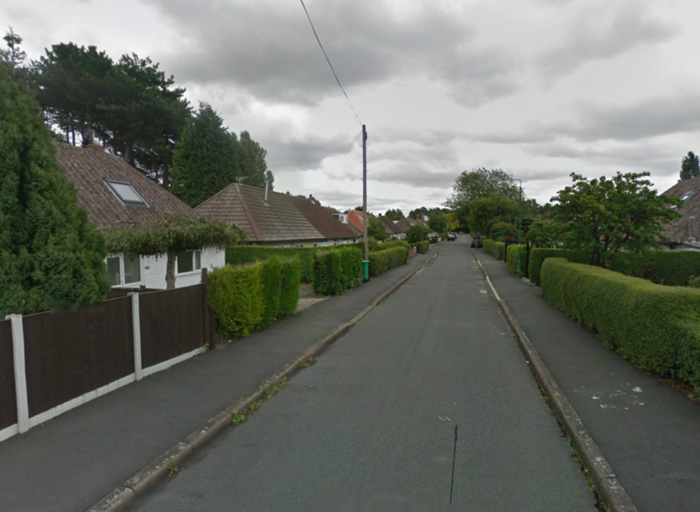
Toston Drive, Nottingham
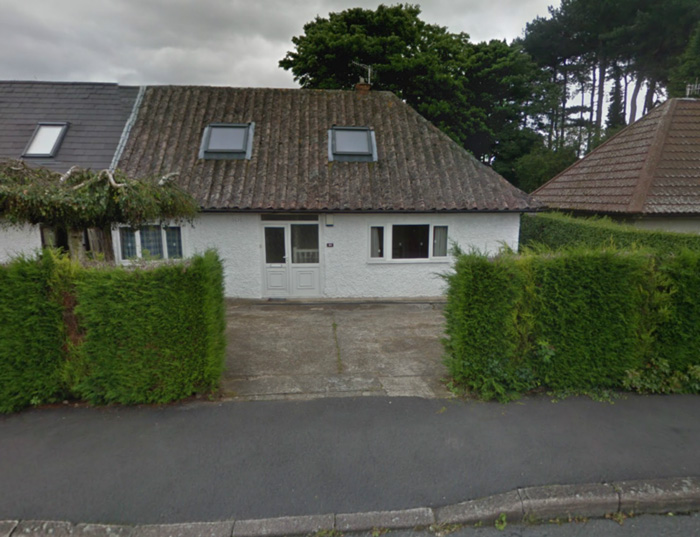
46 Toston Drive, Nottingham - Graham
Barnes' homestead Many Thanks to Martin Crich
for sharing his photos with us
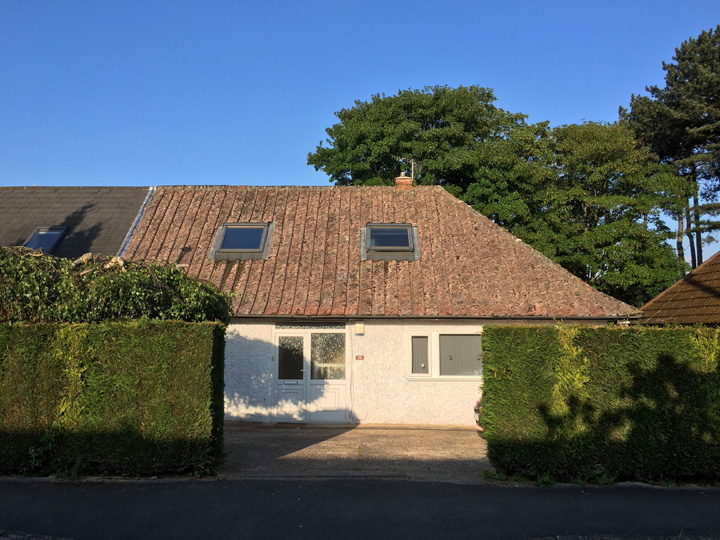
Many Thanks to Axel Zirkel for sharing his photo with us (from 2018)
|
Fair Thee Well – As Margaret Glen-Bott-Secondary
School Closes It’s Doors
Which is Graham
Barnes, as he was affectingly known back in his youth, before
changing his name to Alvin Lee, went to school for a short
period of time. His old alma-mater has now closed its doors
for good, but two of its most famous pupils will always be
associated with this fine institution. Alvin Lee of course
and Richard Beckinsale.
Alvin was one of the
very first pupils to attend Margaret Glen Bott where he was
something of a “Rebel” as he was often being sent back home
after just arriving at school, for wearing unsuitable for
proper education – “Rock `n´ Roll” clothing. (way to go
Alvin). As if this wasn’t enough, the head teacher at the
time, one Miss Lovatt, gave Mr. Barnes a good dusting down,
by spewing this good advice to our soon to be guitar hero,
“Smarten up and get rid of that guitar, as you’ll never make
a living out of it”. This was most likely the only time that
she was so very wrong ! Although Alvin’s favourite teacher
was a chemistry teacher whose lessons he enjoyed so very
much, that he held the top grades in his class. But behaving
nicely in a smart new school in Wollaton Park didn’t sit
very well with him either.
Alvin kept his
guitar hidden under his desk and used to practice his chord
shapes, patterns and structures whenever he was bored. He
left school at age fifteen, with no personal regret at all,
as he was already proficient enough playing guitar since the
age of twelve, to comfortably able to move on. As you can
see for yourself in the photos above on this page, an early
Alvin Lee playing in
“The Jaycats” with Ivan Jaye Harrison as their lead singer,
Leo Lyons on bass guitar and Pete Evens on drums”. Later on
in the official press / publicity photos as the “Jaybirds” it’s
Alvin Lee, Leo Lyons and Dave Quickmire as a working trio.
With the final line up becoming, Alvin Lee on guitar and
vocals, Leo Lyons on bass guitar, Ric Lee on drums, (pulled
away from the very popular Mainsfield’s ) and Chick
Churchill on keyboards, “Ten Years After”
was formed. The not yet famous foursome would, in a few
years hit the big time playing the now historic “Woodstock”
music festival in August of 1969. The group would also be
featured in the classic documentary “Woodstock Movie” that
was released about one year after the actual event in 1970.
It’s also been fiercely rumoured, that Ten Years After did
more tours of America, than any other British band, before
or since, a grand total of twenty eight, in a seven year
period. It still stands as a record if true.
Alvin Lee is
regarded as one of the most technically advanced and
brilliant guitarist in the history of Rock and Roll,
although he later became just as distinguished and respected
for his rhythm and blues, country rock and rock and roll,
having release roughly twenty five albums to date, in his
vast career. Alvin now enjoys life in Spain, though his
beloved mother continued to live near Margaret Glen-Bott
School until the end of her life. She passed away in May of
2004. Alvin toured the U.K. for the first time in nine
years, which included a prestigious concert in Nottingham at
the Royal Concert Hall. The tour was in support of his brand
new album release called, “Alvin Lee In Tennessee”.

Front View

Main Entrance
What follows, is
Alvin’s own recollections of his time at Margret Glen–Bott
Secondary School:
"I was a rebel at
school and I suffered the consequences because of it."
I was a big fan of
James Dean, who was always the rebel and got the blame for
everything, every time. My teacher, Miss Lovett said that I
wouldn’t amount to much if anything at all. Whenever
something bad happened or went wrong at school, I was
brought in and questioned as to where I was during that time
period. I was always the number one suspect, that was until
I could prove otherwise, which made the situation even more
difficult for me. I had a brand new school, while the other
local ones were very nasty and that was not about to happen
at Wollaton School, they would see to that. Apparently, if
someone was at all acting original, or just thinking out of
the ordinary, so called normal, status quo, had to be kept a
very close eye on. It just so happened, that a brand new
teacher arrived at school, then called my name to stand at
attention, then very sternly announced to the entire class
of my mates, “Yes, you are under my suspicion young man, so
be careful” which was not at all conducive to my education
at all. Just maybe I could’ve tried to impress him, but he
had already killed my spirit straight off. So then, if
that’s your bloody attitude, I’ll do something just so
you’ll never forget me. Most of my formal education involved
remembering certain important history dates. I don’t have a
clue or really care at all about dates, although one always
sticks in my mind it was 1066 and the Hastings Battle I
believe it was. And the only time that it came in handy was
playing a board game with my family. The funny thing is that
I don't know the names of all the countries around the
world, although I have visited a great many of them and
enjoyed it. Wherever you travel around the world, that’s
what makes it memorable, and not what books tell you its
like. Many teachers in school were busy concentrating on
making students obey and pull their own weight rather than
bringing out the positive that’s in people. Really, there’s
only one woman, who was teaching science, that inspired me
to became first in her class, just because I found her
interesting and excelled to her teaching style straight
away. It was the headmaster who had doubts to my honesty, as
to how I came to be at the top of my class, so they changed
teachers and presented me with a real ignoramus, who just
insisted on putting chemical formulas on paper, to which I
had no desire to do at all. No surprise, my grades fell back
once again. Teachers are a little better these days
intelligent now and observe what motivates students in the
best possible way, and work on their positive parts. Trapped
within a substandard flow was a total dead-end for me. I
mean I like music, but the music teacher's idea of a music
class was to write down the lyrics of hymns. We were so
unruly, that the teacher made everyone write out the same
hymn a dozen times, I got around this by inserting a piece
of carbon copy paper, to which I made a little book out of
it. My reasoning being, there was such a lack of good hymns
this year that I had decided to copy the same one twelve
times. The teacher was very amused and actually thought that
was very funny he kept the book for a long time. I went to
see my vocational administrator and told him I wanted to be
a musician and the reply came back, you’re kidding correct?
The closest thing we have for you, is military life, which
isn’t at all what I had in mind !
The second famous
Nottingham resident to attend the same school as Alvin Lee
was, Richard Beckinsale.
Who, like Alvin, packed up his belongings and left school at
fifteen years old as well. He took on many different jobs
while studying at Clarendon Collage to acquire further
qualifications, and won a place at R.A.D.A. He broke into
Television with a small role in Coronation Street, but he is
probably best known and remembered for his outstanding
performance in “Raising Damp and Porridge”. Richard had a
daughter, Samantha, who also became an actress, with his
first wife Margaret. Later on he married Judy Loe with whom
he had another daughter, Kate, who is now a top screen
actress.
Richard died
tragically young, the victim of a massive heart attack in
1978, at the early age of 31.
By Helen Whitehead – Editor of Fair-well To Margaret Glen
School. |
ALVIN LEE - In his own words
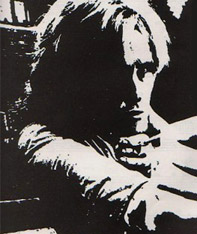

From The
Ten Years After Songbook Volume 1,
Thoughts
from Alvin Lee himself on the meaning
behind twelve of his songs:
1. Rock
and Roll Music to the World
The
magic invocations, the wish of me to play anyone,
music, for the sake of music, because music is a true
essence.
I realized that the
T.V. was wasting my creative time
and I was becoming aware of too many unpleasent or
useless events, which in previous generations was not
the case. After
suffering from an overload of inputs to the brain (Lane's
theory) I cut myself from all entertainment and news
media as an experiment. Creation improved, but I noticed definite
T.V. withdrawl symptoms, as usual compromise was the
solution.
Strange
words that wrote themselves and do not relate to me in
anyway (in this life).
I
decided to indicate that I was not involved in hard
drugs. Many people were assuming that I was into heavy
dope and I did not wish to contribute to the
increasing use of bad medicine.
5. I'd
Love to Change the World:
On the
news media again. I realized that the world was definitely not living up to my
hopes, I find it
difficult enough to control my own life. Yes the
world could use some changes, but who can make
decisions for other people's lives, only the ignorant
I fear.
So many
stars, so many solar systems, so many galaxies and so
much time, one day we will be contacted.
I have
the ability to associate with any emotion imaginable,
I call this song "Caucasion Spiritual" to
indicate my sympathy with the suppressed Negro work
songs that I grew up with.
A despairing song brought on by a godless cosmic
revelation.
An
invitation to suppressed females to get it on, it
liberated me.
This is
the equivalent to a chain gang work song, only as I
envision it could be in the future.
Shortly
after this song was written I dropped out for three
months to recover from an outburst of lethargy.
I wish
to encourage all individuals to explore their
individuality, break the umbilical cord and try it
your way, it's the only way.
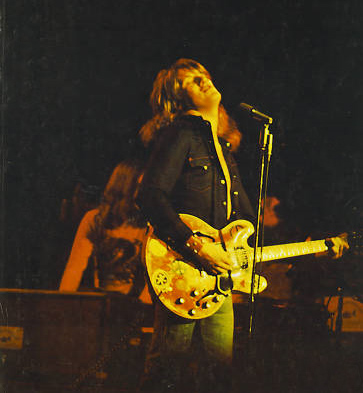
Ten
Years After Songbook Vol. 1
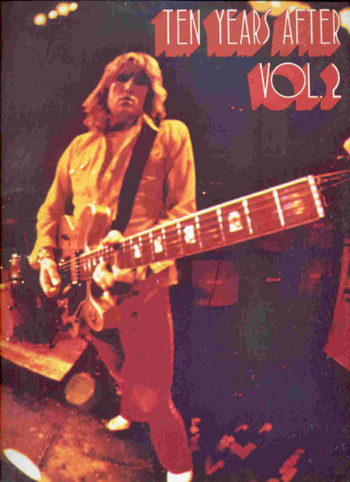
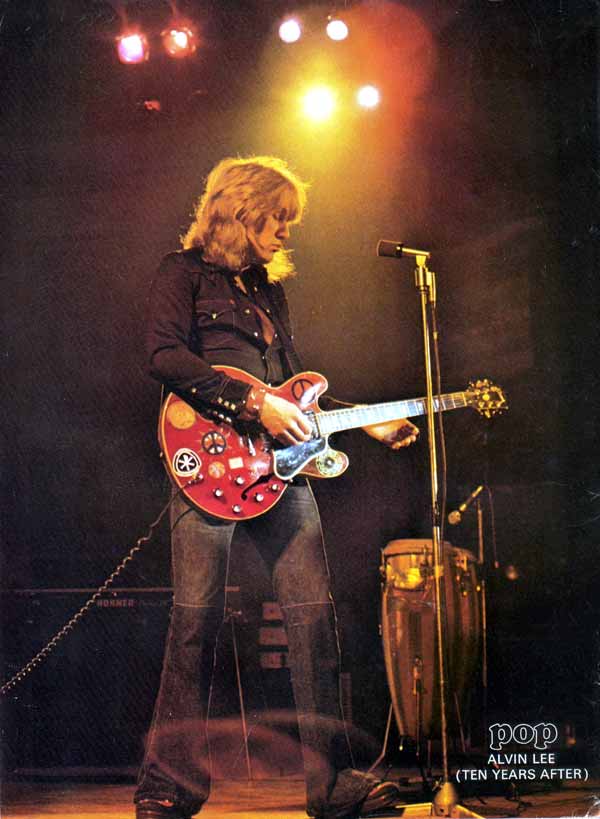
Many Thanks to TYA Fan JOHN TSAGAS for contributing
this picture to our website
|
| Alvin Lee’s
Guitars and Setup: “I’m just a curly lead into the amp kind of
bloke” says Alvin.
Alvin Lee’s famous
cherry red ES-335 Gibson guitar, is his one and only stage
guitar.
In his own words:
“Nothing else has ever come close”, Alvin’s very unique sound
is the result of the installation of some single coil pickups,
along with the ever familiar hum-buckers along with his
trademark Marshall combo. It was a match made in heaven, as
far as the Ten Years After front-man was concerned. Although
in the true musicians style, he’s constantly on the lookout
for that elusive combination that just might prove to be one
notch better.
“My style comes from
experimentation, the more you do, the longer you jam a solo,
the more inventive you get”. “The ES-335 came from Chuck Berry
really. But I found that if you cranked the ES-335 up loud,
you just make it uncontrollable, and the Les Paul was too
heavy, while the Stratocaster was too thin sounding. The way I
play, my little finger sort of floats over the strings and
below. When I’d solo on the Stratocaster, I found I used to
turn the volume down by accident, until you couldn’t hear me.
I thought it was my amp, or just my hearing that was going for
awhile”.
“My ES-335 is a 1958
model that I bought for 45 pounds, including the carrying
case. Until recently I only used it with my Marshall 50 watt
combo, the output of my guitar, matched the input of my amp
perfectly, and if you ever find a combination like that, you
have to stick with it. I also avoid effects. I think the only
one that I use is an Ibanez Tube Screamer in the studio for a
little presence”.
“I recently got into
the Marshall Jubilees. They’re the only one’s that I’ve found
that do the job as well as my 50 watt. I used to take it down
there, because I’ve known Jim Marshall a while, and do
comparisons. Finally, one came up that I liked”.
“My soloing has that
jazz sensibility to it, where I bring down and bring it back
up again, to return to the main themes and stuff. My style
comes from experimentation, the more you do, the longer you
jam a solo, the more inventive you get”.
Alvin’s Guitar
Collection…
From Alvin’s personal guitar collection, he has a rare
non-tremolo, maple neck, two tone, Sunburst Fender
Stratocaster that he bought from a young lady in Texas. It
came complete with matching tweed covered Fender Deluxe
amplifier. To which Alvin paid exactly $400.00 for the entire
lot. The girl owner bought them, then took one week of guitar
lessons, and then put them away in the attic. This guitar is
particularly unusual (rare), due to the fact that it is serial
numbered and dated to the late 1960’s – which by this time
Fender Stratocasters had changed to slab rosewood fingerboards
and three tone sunburst. It’s presumed, that due to the lack
of demand for non-tremolo models, Fender assembled this guitar
from older parts which they had laying around on the shelf. |
|
 ALVIN LEE’S 1958 GIBSON ES-335 ALVIN LEE’S 1958 GIBSON ES-335
By
Alan Paul
Blues
rocker and pioneer shredder Alvin Lee is best known for
the extended show – stopping version of
“I’m
Going Home” he and his band Ten Years After played at
the original Woodstock Festival in 1969.
He
used this Gibson ES-335 at Woodstock and on everything
from Ten Years After’s 1967 debut, to his 1994 solo
album, “I Hear You Rocking” (Viceroy). “I bought
“Big Red” in 1963 when I was 18 for 45 pounds, case
included,” the British guitarist says. “I always
wanted an American guitar, that was the holy grail, and I
especially wanted a Gibson ever since I saw Chuck Berry
and Elvis Presley’s head guitarist – Scotty Moore
playing them. “When I bought it, the pickup
configuration was normal, but I immediately took the
covers off to give it a little more kick and top end.
I’ve always been an amateur boffin (tech). I liked the
Fender sound and always thought it would be great to have
a half and half guitar, so eventually I put in a middle
Strat pick-up, which has a nice hollow sound. I also put
on a TP-6 tailpiece with fine tuning as soon as they came
out.”
Lee’s
Woodstock triumph established his reputation and gave Big
Red one of its more prominent “tattoos”.
“When
I was on stage at the festival, a Woodstock sticker
somehow got passed to me while I was playing, and I just
slapped it on. The peace stickers came to me in a very
similar manner in 1967 at the Fillmore West in San
Francisco, and the rest just somehow appeared. In 1973 I
broke the neck off, and when they replaced it, they
re-lacquered the guitar, so the stickers became permanent
fixtures, which is fine. “Heritage is now making an
Alvin Lee model guitar which is, in most respects, an
exact copy of this one, though they also have a Kahler
wang bar. I really like it, but I didn’t want to
desecrate the Gibson wood with such a thing, so now I use
both guitars”.
Photograph
By Kim Tonelli
|
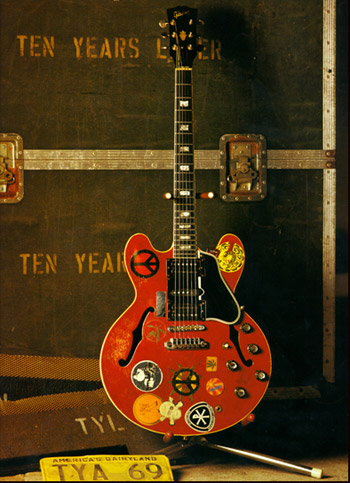
Alvin’s
“Big Red” Today
The fact is, that Alvin no longer does extended
tours, but only the rare gig here and there, thus his
prized instrument “Big Red” has been retired. Although
the Gibson Guitar Company has gone out of their way to
produce a copy of his treasure, (but nowhere like the
original one played at Woodstock) the famous Big Red is
now too valuable to take on the road, and much to costly
to insure. Rumour has it, that Alvin has been offered in
excess of half a million dollars for it. If true, not bad
for a ninety dollar guitar purchase.
|


 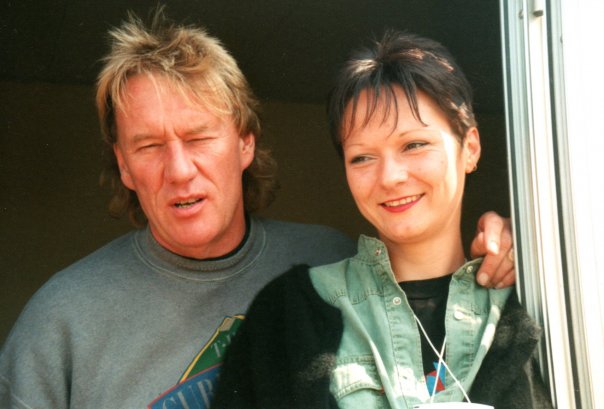
|
|